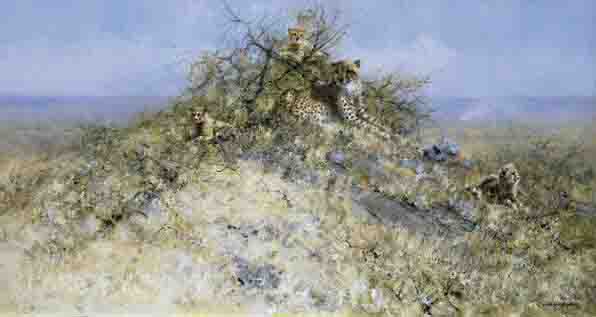Best spots on hill
David Shepherd

Best spots on the hill
Signed, limited edition of 950
Published soon
Image Size 15" x 30"
Complete with Limited edition Sketch.
(p & p charged at cost)
The king cheetah is a variety of cheetah with a rare mutation for cream-coloured fur marked with large, blotchy spots and three dark, wide stripes extending from the neck to the tail.
In Manicaland, Zimbabwe it was known as nsuifisi and thought to be a cross between a leopard and a hyena.
In 1926 Major A. Cooper wrote about a cheetah-like animal he had shot near modern-day Harare, with fur as thick as that of a snow leopard and spots that merged to form stripes.
He suggested it could be a cross between a leopard and a cheetah. As more such individuals were observed it was seen that they had non-retractable claws like the cheetah.
In 1927, Pocock described these individuals as a new species by the name of Acinonyx rex ('king cheetah').
However, in the absence of proof to support his claim, he withdrew his proposal in 1939. Abel Chapman considered it a colour morph of the normally spotted cheetah.
Since 1927 the king cheetah has been reported five more times in the wild in Zimbabwe, Botswana and northern Transvaal; one was photographed in 1975.
In 1981, two female cheetahs that had mated with a wild male from Transvaal at the De Wildt Cheetah and Wildlife Centre (South Africa) gave birth to one king cheetah each; subsequently, more king cheetahs were born at the Centre.
In 2012, the cause of this coat pattern was found to be a mutation in the gene for transmembrane aminopeptidase (Taqpep), the same gene responsible for the striped 'mackerel' versus blotchy 'classic' pattern seen in tabby cats.
The appearance is caused by reinforcement of a recessive allele; hence if two mating cheetahs are heterozygous carriers of the mutated allele, a quarter of their offspring can be expected to be king cheetahs.
Sir William Russell Flint here.
Back to David Shepherd prints for sale.